News
MA1 “Abstract Originals” – 7 generated art displays (below)
Geoff Davis MA1 artworks are available as new format collectables via elementum
Above: Geoff Davis MA1 “Abstract Originals” set, Lines (1984).
Micro Arts’ Geoff Davis computer generative art is now in the Francisco Carolinum Museum, Linz, Austria; the Franke Foundation collection, Germany; the Computer Arts Archive, UK; the Le Random collection; and with many international collectors.
New edition 2.5 of the AI Creative Anthology

New artists, new cover.
Visit Geoff Davis Org to get your free 486 page book
Educational pdf or epub available free – with Ana María Caballero, Sasha Stiles, Patrick Lichty, James Bloom, Johnny Dean Mann, Brian Reffin Smith, Geoff Davis, plus 20 stories from the First edition and articles on Anna Ridler, Damien Hirst, Ai Weiwei, Refik Anadol and many other artists.

I was a guest speaker at the Pioneers day of the Generative Art Summit from the Herbert W. Franke Foundation in Berlin 3-6 July 2024.
“From Camera to Artificial Intelligence 1954 – 2024 – International Conference.”
Organised by art meets science – Foundation Herbert W. Franke – Academy of Arts, Berlin.
For more information see this: Generative Art Summit
Contact & Socials
geoffdavis5 at gmail dot com
@microartsgroup
https://www.instagram.com/microartsgroup/
https://www.facebook.com/microartsgroup/
Fiction or Filing? This is a pdf essay about Non Linear Narrative, which has Micro Arts MA4 Story Generator, and The Money Work System (SCUM Manifesto) from MA2 Various Unusual Events, plus some of my fictions. This is a new version for 2024, from the 2003 original.
FICTION OR FILING – GEOFF DAVIS – 2024 Short version
Geoff Davis – TIME SPECTRUM Generative art
Please check out TIME SPECTRUM interactive art – Expanded Art on fxhash – can be seen and remixed free online.
Attractive abstract art for display, or the colors can be radically remixed as it is running. Like a creativity app. Watch this:
Solo Exhibition – 1-12 DECEMBER 2023
https://www.expanded.art/exhibitions/geoff-davis-time-spectrum
Berlin Exhibition 2023 at EXPANDED.ART
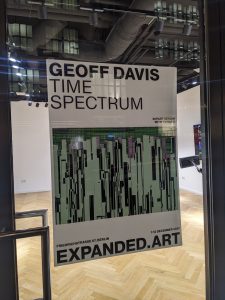


Hans Dehlinger & Geoff Davis, Berlin 2023

Images below are from generated outputs, different each time, depending on which TIME SPECTRUM you are in. #timespectrum #fxhash #expandedart #computerartssoc #microartsgroup #geoffdavisuk
For my main site please visit Geoff Davis dot Org
 Micro Arts Group
Micro Arts Group
Micro Arts Group is a generative computer art group founded in 1984 by Geoff Davis along with an international group of young artists and programmers. It released 4 curated data cassettes of programmed art works ranging from longform generative art to text story generators. It also produced a print magazine which had the first published art from a real artist using the new ‘paintbox’ graphics system, and found a resting place on Prestel, a pre-internet teletext system.
NEWS November 2023
Expanded.Art are publishing a Pioneer Grail of one of the MA2 pieces ‘Piano Bar‘ with music. This will be available from 4pm CET 2 November 2023 to 4pm CET Sunday 5 November. Please find out more on Expanded Art’s website.

Expanded.Art also have a listing of long form generative art from MA1: “Abstract Originals” originally from elementum.
This is a full list of 1980s releases:
MA1: “Abstract Originals” – Geoff Davis (7 segued long form generative art programs, with menu control) 1984
MA2: Various Unusual Events – Geoff Davis (6 events – code art, a SCUM Manifest animation, generative graphics etc., minimal pixel art, with menu control) 1984
MA3: Volume 1 – Martin Rootes (animated art programs, based on Muybridge, Duchamp etc.) 1984
MA4: Story Generator – Geoff Davis (early AI text story generator, from short story seed) 1985
First Quantel or Lumena Paintbox art published in the print magazine in 1984.
Involved with Network 21 pirate TV station.
There was also a print magazine, and an exhibition in 1985. It was all put on Presetel teletext in 1985.
It has been revived recentlyby the Computer Arts Society (part of Computer Arts Society CAS) and now has regular exhibitions, and is in the Computer Arts Archive.
More details are below, or use the menus for dedicated pages with videos of each release.
MA1 ” Abstract Originals”

Geoff Davis MA1 Lines Grid 64, a time slice image showing the progression of ‘Lines’, one of the original long form generative artworks.
Visit the Micro Arts releases page (still images, videos and Magazine also from top menu)
Use the menus to expolore the rich history of Micro Arts Group.
The context was the experimental and grassroots art scene in London. Geoff was involved with the London Film-Makers Co-Operative and London Video Arts in the preceding period. He wanted to apply the same experimental and accessible approach to computer art. Since there was no digital arts organisation at the time, he set up Micro Arts. The Computer Arts Society, formed after the Cybernetic Serendipity exhibition, was not active (“dormant”, Paul Brown) in the 1980s and reformed later.
 LFMC poster image NW1 1985
LFMC poster image NW1 1985
Casey Reas (Processing) has discussed the importance of early experimental film and video for digital computer generative art in an interview in Le Random generative art site.

Geoff Davis at Leicester LCB Depot exhibition 2021, curated by Sean Clark.
NEWS – FREE EBOOK
Second edition of Book – Micro Computer Art in the 1980s – is out soon. In the 1980s, many popular digital art genres changed or appeared – generative and algorythmic art, (pre) pixel art, gaming, 2D and 3D animation, paint systems… so much, from DIY ‘kit computers’ to modern ‘workstations’.
 Micro Arts Book Second Edition cover (temporary)
Micro Arts Book Second Edition cover (temporary)
The view from now, backwards into the depths of time, will be used. Rather than assuming everyone knows what the activities in the 1980s meant. The 1980 ‘electronic decade’ will be discussed. Will also be a FREE EBOOK.
Geoff Davis went on to teach in various art colleges and universities, and is now an AI Arts researcher into bias at the Creative Computing Institute, UAL, London. Has is a published fiction author and several works had digital media games or animations. He gives regular talks for the Computer Arts Society on AI and Art. He is a committee member of the CAS and on the selection committee for the Electronic Visualisation & the Arts EVA London conference.

Georg Bak, curator, elementum.art talking to Geoff Davis, Zurich 2023.
Low cost readily available microcomputers were used to create generative, text and conceptual art for distribution to the public. This was the first time computer art appeared outside of academia or research labs, and first time curated generative and conceptual art was publicly distributed.
The generative art for MA1 “Abstract Originals” was coded in 1983. A screenshot is on the Micro Arts Grid 88 artwork. Micro Arts released curated sets of computer generated art and conceptual pieces in 1984. In 1985 MA4 Story Generator was released, and ‘early precursor of ChatGPT’ according to historian Georg Bak. Art was distributed on data cassettes and the pre-internet Prestel (like Minitel) teletext.
There was also an educational print Magazine, which provided a forum for computer artists and musicians. This had the first ever paintbox image published by an artist. (Made on Quantel hardware, or Lumina, in Paris, we believe in this case.) This was two years before David Hockney was ‘playing with light’ on the BBC. Micro Arts also did computer graphics for the London pirate TV broadcaster Network21 with Bruno DF.
It was well reviewed in the mainstream computer press such as Computer News, Personal Computer World, Blitz fashion magazine, A&B Computing, Sinclair User and Acorn User. The microcomputers used were the Sinclair Spectrum and the BBC Micro, iconic machines from the early 1980s, plus other art using the Quantel Paintbox, the first video computer graphics machine.
Photos used with permission.
NEWS
JULY 2023
Computer Art Society Exhibition 2023
Opens 10th July 2023 – on for 3 months.

Over 50 artworks by over 40 artists, including Geoff Davis founder of Micro Arts with Pattern City
please visit CAS Exhibition 2023
where you can book tickets for the opening 6pm Monday 10 July.
BCS Moorgate, Ground Floor
25 Copthall Avenue
London, EC2R 7BP
July 2023
Geoff Davis and Micro Arts Group are in THE THINKING MACHINE show from Expanded Art / Anika Meier in Berlin, it starts Tuesday 6th June 2023 to 27th June. Please visit https://www.expanded.art/exhibitions/the-thinking-machine
Please also visit the MA1 “Abstract Originals” (shown in Berlin above) on elementum.art curated by Georg Bak
 Thinking Machines Berlin 6 June 2023, local poster by Geoff Davis
Thinking Machines Berlin 6 June 2023, local poster by Geoff Davis
“The exhibition presents pioneers from different generations, early 1950s until today, working in the field of generative art. On view will be, among others, plotter drawings, generative photography, sculptures, and NFTs from 25 international artists.”
This is SO AMAZING! Thanks to Anika Meier and Georg Bak and everyone else who put on this exhibition.
Artists: Ai-Da Robot, Victor Acevedo, Vladimir Bonačić, Analivia Cordeiro, Pierre Cordier, Geoff Davis, Hans Dehlinger, Primavera de Filippi, Herbert W. Franke, Hein Gravenhorst, Ira Greenberg, Samia Halaby, Heinrich Heidersberger, Karl Martin Holzhäuser, Roger Humbert, Gottfried Jäger, Mario Klingemann, Zach Lieberman, LoVid, Kevin and Jennifer McCoy, Lee Mullican, Frieder Nake, Aaron Penne, Manuel Rossner, Marcel Schwittlick, Travess Smalley, Marina Zurkow.
Micro Arts Group 40 years -Generative Art on Data Cassettes to 3D VR and new format art – 1983 to 2023 (this is a 49 grid)
 Grid History Micro Arts Group 1983 – 2023 – 40 years!
Grid History Micro Arts Group 1983 – 2023 – 40 years!
A larger version of this was in the elementum Zurich 2023 exhibition curated by Georg Bak
JUNE & MARCH 2023
Geoff Davis AI Talks for the Computer Arts Society
AI Image Talk CAS Geoff Davis 2023 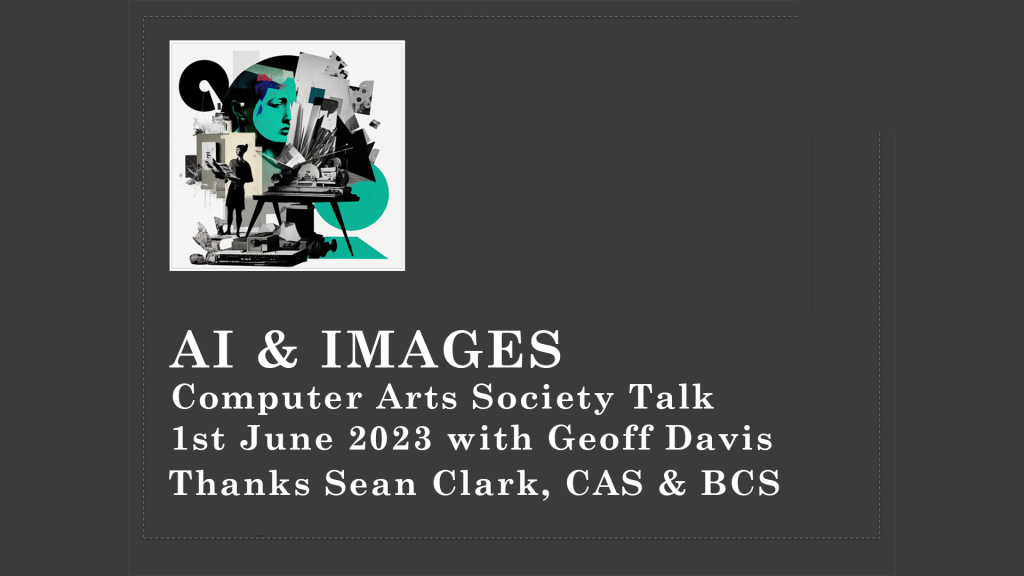
Geoff Davis did 2 AI talks for CAS, AI and Text (March) and AI and Image (June).
AI & Text Talk CAS Geoff Davis 2023:
Please visit CAS Talks for the more information.
The 2 x AI talk Transcripts are on the Geoff Davis website
MAY 2023
Geoff Davis edited this AI and Creative Writing book, and has a few pieces in it:
AI Creative Writing Anthology: 20 Authors Share How to Use Computer Tools
 AI Creative Writing Anthology Geoff Davis
AI Creative Writing Anthology Geoff Davis
Visit Goodreads for reviews, sample, purchase links.
https://www.goodreads.com/book/show/123894053-ai-creative-writing-anthology
FEBRUARY 2023
Gallery show and drop: Launch of new Micro Arts Cube videos and Micro Arts Grid 88
with elementum.art Zurich Switzerland
 geoff Davis Georg Bak Zurich 2023
geoff Davis Georg Bak Zurich 2023
Please click here to visit elementum.art
Thanks to Georg Bak (Zurich) and Dr. Sean Clark (London CAS/BCS and Leicester Depot/Computer Arts Archive).
Why Cubes?
There are no cubes. There is only the generative art indicating a cube. How conceptual!
When making these videos, I wanted a 3D animation to display the generative art. The video came out really well. Patryk Jaworski (Leicester) did the 3D work and made the video.
 MA1 Cube Data Geoff Davis / Patryk Jaworski
MA1 Cube Data Geoff Davis / Patryk Jaworski
First thing, these cubes do not exist in the videos, they are perceived because of the perspectives on the moving generative art. The perceived depth masking is also an illusion. Can you see any cube?
Cubes in history (edited)
Cubes have a history in art. Reviled by Futurists as not dynamic enough (referring to the early ‘analytic’ cubism) in ‘The Painting of Sounds, Noises and Smells’, Marinetti, 1913, and later admired by conceptualists. Cubism! Followed by Sol LeWitt’s ‘Variations of Incomplete Open Cubes’ (1974) and Manfred Mohr’s ‘Cubic Limit’ series from 1973. In the media, Star Trek, the Borg spaceship is in sharp contrast to the sleek curves of the Starship Enterprise.
There’s also the link to modern CGI graphics as used in movies, and everywhere else. Cubes are a 3D primitive used in computer graphics from the start of the industry.
Why move?
If you wonder why these generative images move at all, since modern generative art is often presented as stills, eg Fidenza by Tyler Hobbs, in the 1980s I was involved with the London Film-Makers Co-op and London Video Arts, and indie video for bands like The Fall, Win, Aztec Camera directed by Derek Jarman and the super talented Cerith Wyn Evans, and others. So moving images was normal for me. Not stills. Nothing was printed until the LCB Depot 8-bit exhibition in 2021 and that also had a monitor running the MA1 series. The LFMC exhibition in 1985 was all on monitors.
Now, if you look at ArtBlocks, Fidenza, etc, it’s all stills. ‘Long form’ is some kind of amazing thing. This ‘stills from computer overproduction’ really helps with NFTs. For instance, in making the MA1 Lines Grid 64 images which is on Instagram and shown below, my video editing program made 1330 still images by basically pressing a button. Incidentally in my creative AI research I have located this overproduction as a key part of working with AIs. On the other hand, time slicing anything will result in a lot of samples or editions (or slices).
Geoff Davis MA1 Lines Grid 64 from “Abstract Originals” – time slice.
 Geoff Davis MA1 Lines Grid-64 Time Slice
Geoff Davis MA1 Lines Grid-64 Time Slice
Metavista – music on the new cube videos
Now on Spotify etc.
Micro Arts Group was founded in 1984 by Geoff Davis along with an international group of young artists and programmers. Low cost readily available microcomputers were used to create generative, text and conceptual art for distribution to the public. This was the first time computer art appeared outside of academia or research labs, and first time curated generative and conceptual art was publically distributed.
The generative art for MA1 “Abstract Originals” was coded in 1983 – it’s on the grid above. Micro Arts released computer generated art, conceptual pieces and story generators on data cassettes and pre-internet Prestel (like Minitel) teletext, produced an educational print Magazine, and provided a forum for computer artists and musicians.
It was well reviewed in the mainstream computer press such as Computer News, Personal Computer World, Blitz fashion magazine, A&B Computing, Sinclair User and Acorn User. The microcomputers used were the Sinclair Spectrum and the BBC Micro, iconic machines from the early 1980s, plus other art using the Quantel Paintbox, the first video computer graphics machine.
There was also an educational print Magazine which published the first Quantel art in 1984, two years before David Hockney was ‘playing with light’ on the BBC. We also did idents for the London pirate TV broadcaster Network21 with Bruno DF.
QUICK LINKS
Videos of generative computer art
We are featured in the UK’s national Computer Arts Archive
 Micro Arts on Computer Arts Archive 2021
Micro Arts on Computer Arts Archive 2021
Read academic paper on Micro Arts by Professor Sean Clark: Revisiting and Re-presenting 1980s Micro Computer Art
There is a detailed book History of Micro Arts 1984-85
For artist information see People
Geoff’s AI research and new fiction news on the Geoff Davis website
ORIGINALS
There were many art history firsts:
- Geoff Davis generative art and text story generators from 1984, with long form generative art coded in 1983, in releases MA1 “Abstract Originals”, MA3, MA4.
- Martin Rootes abstract and works inspired by Muybridge, Mondrian etc.
- pixel art & slow art, first single pixel art, and a 2 year art program (MA2 Minimal)
- public digital art collections distributed data cassettes 1984, and Prestel (similar to Minitel, Viewtron) teletext pre-internet, from 1985 onwards
- endless short stories displayed onscreen in MA4 Story Generator
- the first Paintbox (Quantel) art by French artist Michèle Gauthier Carr-Brown published in 1984, in the Magazine
- print Magazine with educational articles and art
- conceptual digital art in MA2 Various Unusual Events
- code art, math art and code onscreen with sound (MA2 Carry On Computing)
- Solanas / Warhol animation about Universal Basic Income UBI (MA2 Money Work System)
- Dada text generator (MA2 Dada)
- woven / scrolling art, Anni Albers art, piano player sequencer, Jacquard loom machine (MA2 Piano Bar)
- combined figurative and generative computer art with sound (MA2 The Studio)
- and more – please research via this website.
This website contains descriptions and photos of all art works produced, and a full copy of the first magazine. The programmers were Geoff Davis (MA1, MA2 and MA4) and Martin Rootes (MA3).
Recent activity
Micro Arts was revived in 2019 by Prof. Sean Clark. He has organised several exhibitions with the Computer Arts Archive (part of CAS). The British Computer Society, Moorgate, London, is exhibiting works until November 2022. Previous shows include LCB Depot Leicester (2021) and the London Film-Makers Co-op (1985).
p>
Above: Geoff Davis at the LCB Depot exhibition, Leicester 2020. Still images display. Live generative art was also shown, and micro hardware, the data cassettes, the Magazine, etc.
Micro Arts was well reviewed in the computer press at the time. Geoff Davis went on to teach and research computer graphics and generated text at Sheffield art college, Middlesex University (Cat Hill), and the London Institute (now UAL).
For news of AI research, the forthcoming AI fiction anthology, and a new novel Circular River, please visit the Geoff Davis website. (Not to be confused with Jeff Davis USA.)
 Circular River cover art Geoff Davis 2022
Circular River cover art Geoff Davis 2022
Micro Arts Group
The 1980s were a time of great change in computer technology, reflected in art production. Micro Arts was not academic or involved in the private gallery commercial art system. There was no interest from galleries at the time unlike now. It was exhibited at the London Film-Makers Co-operative in 1985, where Geoff occasionally worked.
The computer art was programmed for consumer micro computers, the ZX Spectrum and BBC Micro. Commodore, Apple and IBM PC versions were not released. There was also a wide-ranging print magazine. Prestel release was via Micronet 800, editor David Babsky.
2022-2023
New work using the generative art with 3D videos and music, with Patryk Jaworski of Etalon. News of new releases on soon.
Computer Arts Archive: Micro Arts Group is featured in the UK’s Computer Arts Archive.
1980s Releases
This is a full list of public releases:
MA1: ‘Abstract Originals’ – Geoff Davis (7 segued generative art programs)
MA3: Vol 1. – Martin Rootes (animated art programs, based on Muybridge, Duchamp etc.)
MA4: Cow Boils Head – Geoff Davis (text story generator)
Magazine
Free distribution by Arts Express. Page scans are here.
Book
There is a detailed book History of Micro Arts 1984-85
Exhibitions
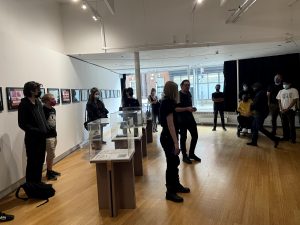

Micro Arts Group – Computer Arts Archive CAA exhibition at BCS Moorgate July 2022 – just launched the Micro Arts Group exhibition curated and launched by Sean Clark during the Electronic Visualisation and the Arts EVA London conference.
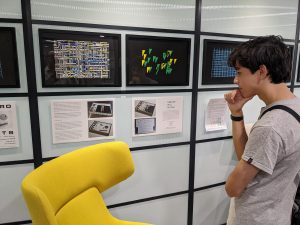

Above: Geoff Davis at exhibition with live running 1980s generative art and print displays

Above: Professor Sean Clark introducing the Micro Arts exhibition, Computer Arts Archive, at BCS Moorgate London July to end September 2022
Read academic paper by Professor Sean Clark: Revisiting and Re-presenting 1980s Micro Computer Art
https://www.scienceopen.com/hosted-document?doi=10.14236/ewic/EVA2021.52
Visit: Facebook CAS Micro Arts Group for updates.

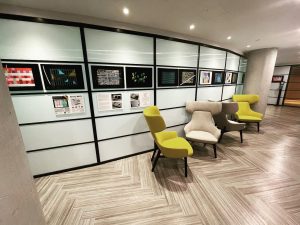
Micro Arts Group exhibition London 2022 at BCS
This is our second recent exhibition, the last was at LCB Depot, Leicester – see photos below, Geoff Davis and documentary maker and 3D videographer Patryk Jaworsky at a later music event (left).
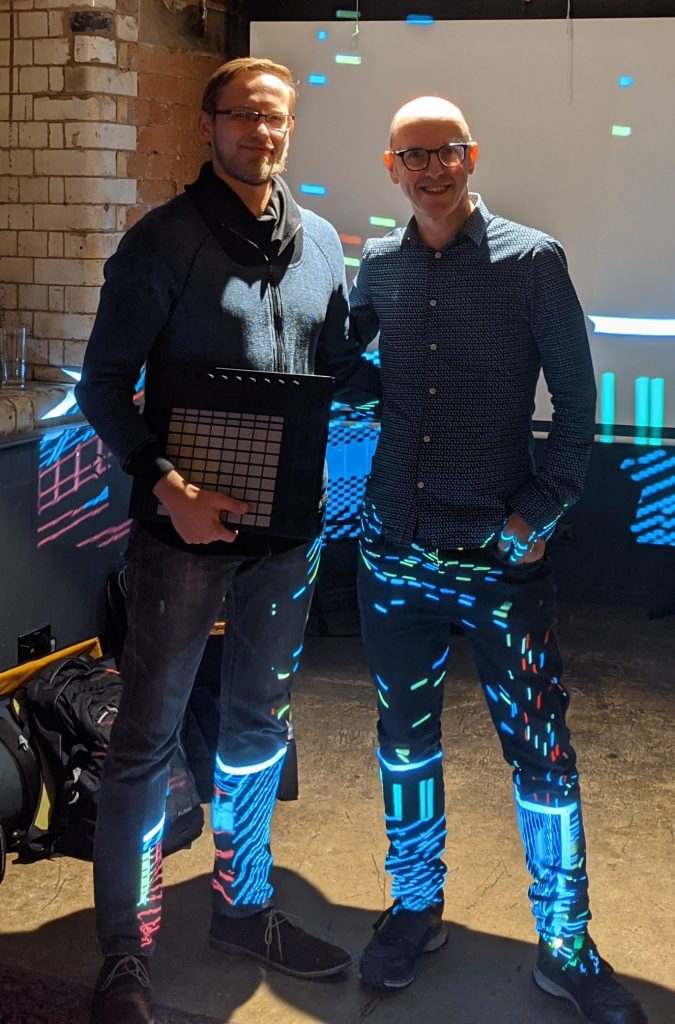
Technology
Micro Arts used only readily available home microcomputers such as the Sinclair Spectrum and the BBC Micro. This was to promote computer art in the nascent domestic computer market of the 1980s. There were other small computers made by Commodore, Atari, Apple, Amstrad, Dragon, Oric, the Acorn Electron (a smaller BBC Micro), and others in the DIY format such as Elektor and Heathkit. Some of these had been around since the late 70s. The IBM Personal Computer (PC) defined a standard open architecture for any manufacturer in 1981, which led to a big reduction in prices, but these were too expensive at the time for general home use.
The later home micros were marketed like other ‘hi tech’ consumer items. The 8-bit ZX Spectrum in particular was very cheap and had what seemed like full colour (16 colours), following on from the black and white of the earlier ZX81. It was easy to program and kick started a new wave of young programmers and computer enthusiasts. The ZX Spectrum and BBC Micro were used for the releases as the two programmers (Geoff and Martin) had purchased them for home use. Kraftwerk’s Computer World album had been a major hit, and the band had featured on the BBC Tomorrow’s World TV science show. Music had become digitised with samplers and techno equipment appearing in the mainstream. The ZX Spectrum SpecDrum was a popular audio sampler, at the start of the electronic computer music scene. This positive vibe was the inspiration for the spoof ‘Clive Sinclair’ inspiring editorial in Micro Arts Magazine, reprinted later.
The Spectrum programs were run on emulators on a PC. Speccy is the one most recently used. The old Spectrum programs are only saved as snapshot files (.sna). We have used various palettes for different purposes. Now we have p5.js versions which are different to the originals. These will be on our new genartists.com website.
Computer Art Background
Geoff Davis had been communicating (by letter) with American computer artist Harold Cohen who produced computer art using small floor robots, called turtles. He was approached to write something about his work and computer art for the Magazine. This never happened. His comment was that everything depended on marketing. How true!
He wrote the AARON software from 1973, to generate art using rules derived from his own abstract painting. The program controlled the turtles’ movement and paint actions. It drew lines flat on a horizontal sheet, and then filled in the shapes. These were quite large, sometimes metres along the sides. Over the years he made AARON more sophisticated, trying to get it to better mimic his creative methods. Later it was programmed to create a field and foreground for the art, with a simple sort of depth, which changed the appearance of the generated art. Cohen coded AARON to produce individual works in his own style, a kind of immortality. Later he moved away from physical art creation and used tablets to make and modify generated work.
The use of a unique machine to create computer art persists in the work of Mario Klingemann with Memories of Passersby I (2018), which has a computer running custom machine learning systems inside a vintage cabinet, making so-called ‘AI art’, mutated reproductions of existing paintings, on two monitors in real time.
The other main type of historical computer art used mass produced machines, and a personal input. Text printer ‘ASCII art’, was coded (or rather, typed in) by programmers using dot matrix printers to create images of Marylyn Monroe, Star Wars, etc. ‘Studies in Perception I’ by Ken Knowlton and Leon Harmon (1966) is the first popular appearance of computer art. ASCII comics also existed. This art form relied on fixed width fonts, and soon became obsolete as newer printers used variable width fonts. At the time it was called computer art but was really a form of typewriter art.
Text and story generation has progressed from simulated chat systems and the Turing Test (such as ELIZA, 1964), to James Ryan’s Sheldon County (2018), a procedurally generated fiction that is converted using a speech generator into a unique podcast for each listener. His program Hennepin uses the ‘world’s biggest spreadsheet’ to generate the fictional worlds.
Micro Arts MA4: Cow Boils Head story generator program (Geoff Davis, 1985) also used a dataset (many lists of words linked to each word in a seed story) to generate stories. This was a simple method to suit the small memory of the micro computer.
The aim of Micro Arts was to take some of these varied computer art ideas and distribute them to the new generation of computer developers and artists, and the general public.
Releases
Micro Arts created generative graphics and art, figurative animations, and text story generation. The menu options provided colour selection, and encouraged using the art generators in a loop, to provide visual ambiance. More detail on each release follows.
There was also Micro Arts Magazine on computer art and music, and theory (or at least some ideas). Articles included popular topics of the day, such as ‘Language as a Virus’ (influenced by William Burroughs), ‘Electronic Beowulf’, synthesiser and computer music etc. All pages from the magazine are included later.
Micro Arts was aimed at artists and the general market. Some of the work, including a continuous story text generator Cow Boils Head, was shown in art exhibitions in London. NetWork 21, the London pirate TV station, later contacted Micro Arts for titles and idents.
Formats and Prestel teletext
Micro Arts software was initially released on data cassettes. Some micro computers used cartridges for software, but these needed special manufacture. By 1985 all of the material, including the art and story generation software, was on TV as teletext in the national Prestel Micronet 800 service. Teletext ran on normal TVs and provided instant news, sports and hobbies, etc., controlled by the remote. Teletext contrasted with the strictly programmed TV schedules. It was the start of the change of television consumption from broadcast only to an interactive service. See later for more on Prestel and teletext.
Hardware
Sinclair ZX Spectrum

This had a, for the time, ‘generous’ 48K of RAM. A standard laptop today might have 4GB RAM. The hardware structure was very simple, and coding was intricate but very flexible.
That’s about a thousandth of one per cent (0.0012%) of current working memory.
“The Spectrum had nothing. Architecturally, it was a really simple machine for a programmer – it was just a load of ram [random access memory] and a processor; and the screen itself was just dealt with as part of the ram. You had to do everything the hard way, but it meant that if you managed to get a sprite moving around on the screen, you’d done a lot of really clever stuff.
“Years later, when that generation of coders grew up, Britain was really punching above its weight in the PlayStation era, when you had the start of games like Grand Theft Auto. The Spectrum bred a generation of really smart programmers.” Ste Pickford, artist and programmer with The Pickford Brothers, quoted in the Guardian 23 April 2012.
Acorn BBC Micro

This was a bigger and more complicated machine that the Spectrum but not as small and ubiquitous as it was over twice the price (a big factor in the 1980s, explaining why the Spectrum became such a hot bed for games programming). The BBC Micro existed for years after in college and school computer labs, as a huge amount of educational software was produced for it. The chip makers went on to produce RISC chips and eventually become ARM, to be bought by the Chinese. Clive Sinclair was knighted.
People
See the People page for more details.
Status
Micro Arts and Micro Arts Group are owned by Story Software Ltd UK.
#timespectrum is now January 17 2024 release on fxhash


